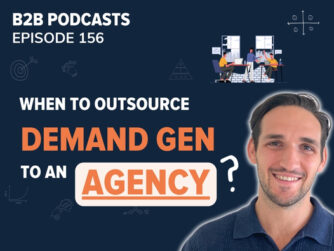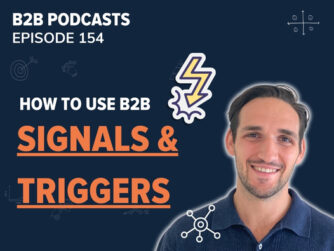Almost every B2B marketer will be assigned the task of lead generation at some point. Particularly in earlier stage companies – that’s what we’re hired to do.
“We want more leads for sales to close”.
So many marketers then follow this process in response:
- They slap together an ebook, guide or something else of value in exchange for a prospect’s email address, job title and company they work for.
- They place this resource somewhere their Dream Customers will see it
- Depending on the maturity of the company, the ‘lead’ will go through a qualification process before it’s handed off to sales
Rinse and repeat.
The team initially gets excited when leads start flowing in. But it’s very likely you’ll start to hear some rumblings from sales about these leads being ‘low quality’. Leads not turning up to meetings. Leads not qualified to buy. Leads not interested in your product or service. It’s a waste of everyone’s time.
My advice is to get ahead of this. Take ownership of the job you have been hired to do. Marketing isn’t just there to generate leads. We’re here to make meaningful contributions to the business, and to help it generate revenue.
So measuring whether or not your lead generation is an efficient process for acquiring new customers for your business is essential.
How To Measure If Your Lead Generation Is Working
If you’re going to evaluate whether lead generation is profitable for your business, you’ll need to consider the costs associated with generating leads and the value of those leads to your business.
At a high level, this is:
Revenue From Leads / Cost To Get Leads
Here’s how to get your revenue number:
- Pick a period of time to measure performance. We recommend 6-12 months
- In your CRM, pull the amount of Closed-Won revenue that came from leads marketing generated
- Adjust the revenue figure if necessary to account for the average Lifetime Value (LTV) of a client
Here’s how to get your cost per lead number:
- Look at data from the same period of time that you analysed revenue
- Sum the cost of advertising to get these leads (the amount you spent on all advertising like Google Ads, LinkedIn Ads, social ads, sponsorships, etc.)
- Sum the cost of tools and tech used (marketing automation tools etc.)
- Sum the cost of labour for this period (salaries and contractors involved in marketing)
Now take that revenue number, and divide by the cost per lead number.
For example, let’s say we’ve gone into our CRM and seen that over the last 6 months, 50 leads turned into closed-won revenue, totalling $150,000.
You can adjust this amount to account for LTV.
Let’s say your LTV is $5,000 – your adjusted revenue figure is: 50×5,000 = $250,000

Let’s see how this weighs against to our marketing expenses over the last 6 months (the same period) to see if we’re profitable.

2 x marketer salaries: $100,000
Tools & tech: $8,000
Ad spend: $100,000
Add these up, and you get Total marketing costs: $208,000
Now to see if we’re making more money than we’re spending:
$250,000 / $208,000 = ROI of 1.2
So for every dollar we spent on marketing, we’d expect to get $1.20 back.
Looks healthy, right?
Take It One Step Further With Sales
If you want to take it one step further, you should also sum the cost of the sales staff required to close those leads. Because remember – it costs money every time they chase a prospect, whether they turn into a paying customer or not.
We may have sent sales 50 leads that close into won deals, but they were just a fraction of the total leads that we sent them to chase.
We might have sent them 2,000 leads over that last 6 months to pursue.
So it’s worth adding the costs of sales chasing all of those leads – because that’s a very real cost on the business.
You might need to work with finance to figure out what this is, but let’s just say you had 4 sales staff chasing these 2,000 leads over the last 6 months, with an average salary of $60,000 each for 6 months.
That’s $60,000 x 4 = $240,000

Now our total expenses are $448,000
And our total revenue is still $250,000
250,000 / 448,000 = 0.56
So for every $1 we are spending, we are only getting back $0.56.
Ouch!
This Is A Common Problem With Lead Generation
This is a very typical scenario when businesses invest heavily in lead generation without examining the downstream effects. It becomes a quantity over quality game, which looks okay until you realise the very real business costs when chasing quantity.
In my experience, marketers often cop the brunt of the blame when the business finally figures out that their lead generation is completely unsustainable. It’s not a nice position to be in, which is why we’ve built The B2B Playbook and The B2B Incubator to share how marketers can generate revenue much more efficiently.









